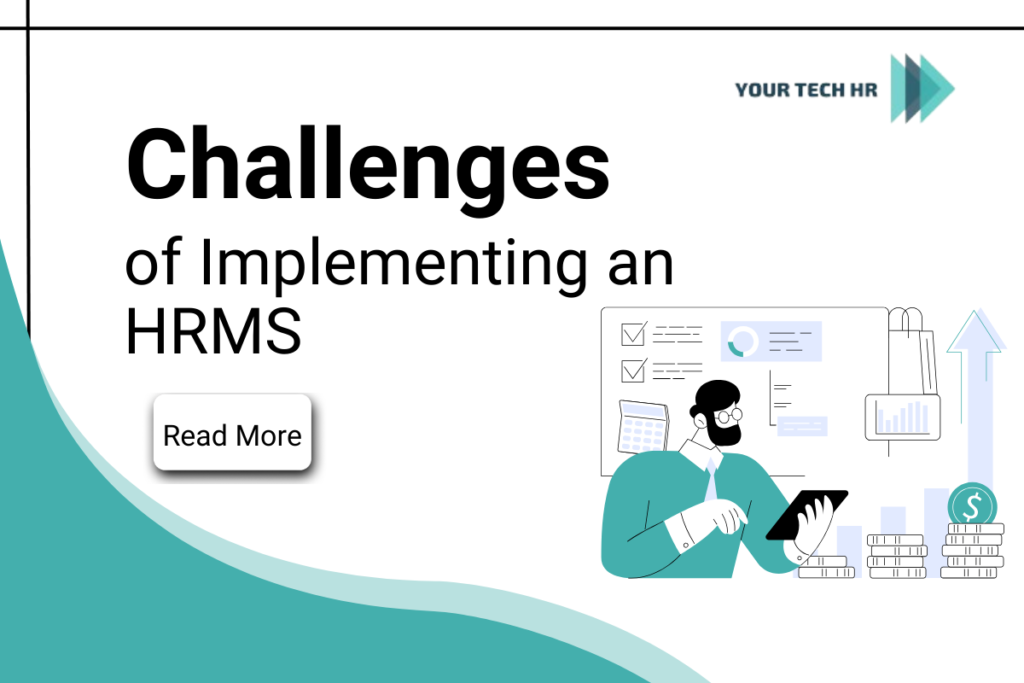Implementing a Human Resource Management System (HRMS) can transform your organization’s efficiency, streamline processes, and enhance employee satisfaction. However, the path to a successful HRMS implementation is often faced with challenges.
This guide will explore these challenges and provide actionable solutions to help you overcome them. Whether you are a VP, manager, business expert, or part of a revenue-generating sector, this blog will equip you with the insights needed to navigate HRMS implementation successfully.
An HRMS streamlines HR processes, reduces administrative burdens, and provides valuable insights into workforce analytics. By automating tasks such as payroll, benefits administration, and performance management, an HRMS allows HR professionals to focus on strategic initiatives that drive business growth.
Challenges of Implementing an HRMS
Challenges in Change Management
One of the biggest challenges is managing the resistance to change. Employees are often comfortable with the current systems and processes, and introducing a new HRMS can create uncertainty and pushback.
Challenges in Data Migration
Migrating data from legacy systems to a new HRMS can be complex. Issues such as data integrity, accuracy, and format discrepancies can arise, potentially disrupting operations.
Best Practices
- Data Mapping: Thoroughly map out data fields and formats to ensure compatibility between old and new systems.
- Testing and Validation: Essential to identify and rectify errors before the system goes live.
- Backup Plans: Always have a backup plan in place to restore data if something goes awry during migration.
Challenges in Employee Training: Preparing Your Team
Training employees on a new HRMS system is crucial but can be challenging. Adequate training ensures that employees are comfortable and proficient with the new system.
Tips for Effective Training
- Tailored Training Programs: Develop training programs tailored to different user roles and levels of expertise.
- Hands-On Learning: Incorporate hands-on sessions where employees can practice using the new system in a controlled environment.
- Ongoing Support: Provide continuous learning opportunities and support even after the initial training phase.
Challenges in System Integration
Integrating the new HRMS with existing systems and software can be challenging. Ensuring seamless data flow and interoperability is critical for a cohesive HR ecosystem.
Effective Integration Strategies
- Identify Integration Points: Determine which systems must be integrated, as well as the data exchanges required.
- Work with Vendors: Collaborate closely with both your HRMS and existing system vendors to ensure compatibility.
- Monitor and Optimize: Continuously monitor the integration performance and adjust as needed to optimize efficiency.
Challenges in Project Management
Implementing an HRMS requires robust project management. Common challenges include scope creep, budget overruns, and missed deadlines.
Project Management Best Practices
- Define Clear Objectives: Set clear, achievable goals and objectives for the implementation project.
- Create a Detailed Plan: Develop a comprehensive project plan with timelines, milestones, and responsibilities.
- Regular Reviews: Conduct regular progress reviews and adjust the plan as necessary to address any issues promptly.
Existing systems in the organization.
What system do you currently use to handle HR tasks? Do you even have an integrated strategy in place to manage payroll and human resources? Or are you still using multiple systems to manage various aspects of your business?
These three questions are the most important because, when implementing an HRMS, you must transfer the data from existing systems properly. If you do not have an integrated system, relocating the data will be extremely difficult.
Finding the Right Service Provider
Implementing an HRMS system in an organization is a primary task that requires a dedicated service provider. A good provider should have a deep understanding of internal systems and focus on implementing the HRMS. This ensures that the integration is meticulous and error-free, allowing employees to focus on their responsibilities. By choosing the right HRMS service provider, you can overcome the challenges of implementing an HRMS system and ensure a smooth transition for your organization.
Managing These Difficulties
These challenges may appear massive. However, there are steps you can take to overcome these challenges. Here are some solutions to help you overcome HRMS implementation concerns within your organization.
Best Practices for a Successful HRMS Implementation
- Develop a Change Management Plan: Engage stakeholders early, communicate the benefits of the HRMS, and provide continuous support to address concerns and resistance.
- Ensure Accurate Data Migration: Conduct thorough data audits, use reliable migration tools, and perform rigorous testing to ensure data integrity.
- Invest in Comprehensive Training: Offer hands-on training sessions, create user manuals, and provide ongoing support to help employees become proficient in using the HRMS.
- Facilitate Seamless System Integration: Work with IT experts to ensure the HRMS integrates smoothly with existing systems and address any compatibility issues promptly.
- Implement Strong Project Management Practices: Establish clear goals, assign dedicated project managers, and use project management software to track progress and resolve issues.
Implementing an HRMS can be challenging, but with the right strategies, you can overcome these obstacles and achieve a successful implementation. By focusing on change management, data migration, employee training, system integration, and project management, you can unlock the full potential of your HRMS and drive your business forward.
Ready to transform your HR operations? Talk to our experts today and discover how we can help you implement an HRMS that meets your unique needs. Let’s revolutionize your HR processes and enhance your organizational strategy together.


